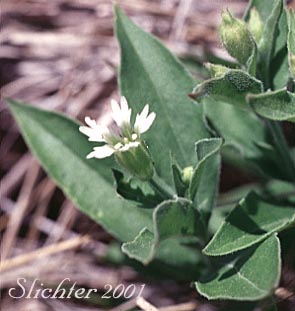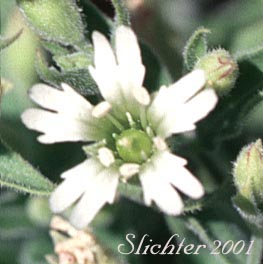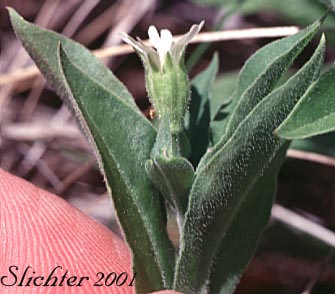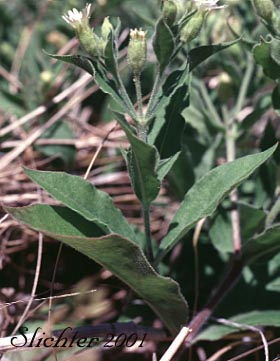

 The
photo at right illustrates the flower of Menzie's campion as found at Horsethief
Butte.........May 31, 2001.
The
photo at right illustrates the flower of Menzie's campion as found at Horsethief
Butte.........May 31, 2001.
Menzie's campion is a somewhat variable low-growing and matted species with numerous spreading to ascending stems which are often freely branched. The stems range from 5-30 cm long and are covered with hairs, with the upper stems usually covered with glandular hairs. The herbage of the lower stems is variable, ranging from covered with non-glandular hairs in variety menziesii and covered with glandular hairs in variety viscosa.
The numerous leaves are found mainly on the stems. Individual leaves range from lanceolate to oblanceolate-obovate in shape and range from 2-6 cm long and 3-15 mm wide.
The inflorescence is a simple to compound, open cyme. Individual flowers have 5 white petals of a rounded oblong shape. The tips of the petals are deeply notched and a pair of lateral lobes is present above the middle of the petal (See photo at right.).
Var. menziesii: Found throughout the range of the species except southern California and most of Nevada. The key distinguishing characteristic is the heavily haired lower stems, the hairs being non-glandular and 3- to 7-celled.
Var. viscosa: Found throughout much of the range of the species but lacking in Arizona, Utah, and New Mexico and much less common in Wyoming, southern Idaho, and central Oregon. The key distinguishing characteristic is the densely arranged spreading and glandular hairs on the lower stem.

Menzie's campion may be found along low elevation streams and in moist meadows.
Menzie's campion may be found from the southern end of Vancouver Island and British Columbia south to southern California and east to Alberta, western Montana, and northern New Mexico. It is not found on the Olympic Peninsula.
In the Columbia River Gorge it may be found between the elevations of 200'-400' between the White Salmon River and the Deschutes River.
